Army "Isthmus". From Honduras to Belize
"Banana Army": how to create the armed forces of Honduras
Honduras is bordered by Nicaragua in the southeast, El Salvador in the southwest and Guatemala in the west, washed by the waters of the Caribbean and the Pacific Ocean. Over 90% of the country's population are mestizos, another 7% are Indians, about 1,5% are Blacks and mulattoes, and only 1% of the population are whites. In 1821, Honduras, like other Central American countries, was freed from the power of the Spanish crown, but was immediately annexed by Mexico, which at that time was ruled by General Augustine Iturbide. However, already in 1823, the Central American countries managed to achieve independence again and create a federation - the United States of Central America. Honduras entered it as well. However, after 15, the federation began to fall apart due to serious political disagreements between local political elites. October 26 The 1838 Legislative Assembly, which met in the city of Comayagua, proclaimed the political sovereignty of the Republic of Honduras. Subsequent story Honduras, like many other Central American countries, is a series of uprisings and military coups. But even against the background of its neighbors, Honduras was the most economically backward state.
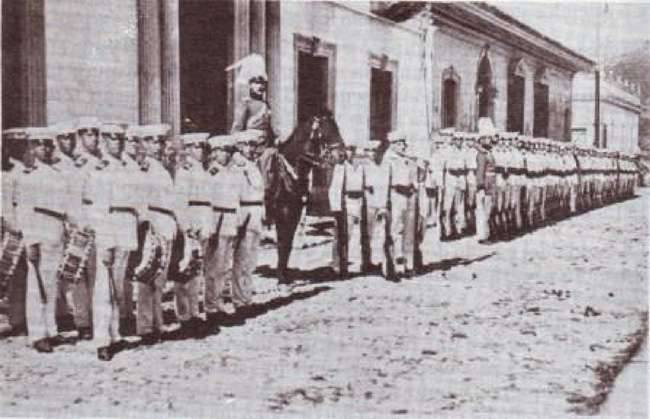
By the beginning of the twentieth century. the country was considered the poorest and least developed on the Central American isthmus, yielding to El Salvador, Guatemala, Nicaragua, and other countries in the region. It is precisely the economic backwardness of Honduras that led him to falling into full economic and political dependence on the United States. Honduras has become a real banana republic and this characteristic can not be taken in quotes, since bananas were the main export item, and their cultivation has become the main branch of the Honduran economy. Over 80% of Honduras' banana plantations were under the control of American companies. At the same time, unlike Guatemala or Nicaragua, the Honduran leadership was not dependent on the situation. One pro-American dictator replaced the other, and the United States acted as an arbitrator, regulating the relationship between the opposing clans of the Honduran elite. Sometimes the United States had to intervene in the political life of the country to prevent an armed conflict or another military coup.
As in other countries of Central America, the army has always played a crucial role in the country's political life in Honduras. The history of the armed forces of Honduras began in the middle of the XIX century, when the country gained political independence, having left the United States of Central America. In fact, the country's armed forces are rooted in the era of the struggle against the Spanish colonialists, when rebel groups were formed in Central America that fought against the territorial battalions of the Spanish captain general of Guatemala. On December 11, 1825, the first head of state, Dionisio de Herrer, created the country's armed forces. Initially, they included 7 battalions, each of which was deployed in one of the seven departments of Honduras - Comayagua, Tegucigalpe, Cholutek, Olancho, Graciase, Santa Barbara and Yoro. Battalions were also named after departments. In 1865, the first attempt was made to create their own naval forces, but they soon had to abandon it, because Honduras did not have the financial resources that allowed it to acquire its own fleet. In 1881, the first Military Code of Honduras was adopted, which laid down the foundations of the army organization and management. In 1876, the country's leadership took the Prussian military doctrine as the basis for the construction of the armed forces. The reorganization of the country's military schools has begun. In 1904, a new military school was founded, which was then led by a Chilean officer, Colonel Luis Segundo. In 1913, an artillery school was founded, whose head was appointed Colonel Alfredo Labro of French descent. The armed forces continued to play an important role in the life of the country. When a government conference of Central American countries was held in Washington in 1923, at which the “Peace and Friendship Treaty” with the United States and the “Arms Reduction Convention” were signed, the maximum number of armed forces of Honduras was determined to be 2,5 troops. At the same time, it was allowed to invite foreign military advisers to train the Honduran army. Around the same time, the United States began to provide substantial military assistance to the government of Honduras, which suppressed peasant uprisings. So, in 1925 3 thousand rifles, 20 machine guns and 2 million cartridges were transferred from the USA. Assistance to Honduras increased significantly after the signing of the Inter-American Treaty of Mutual Assistance in September 1947. By 1949, the armed forces of Honduras consisted of ground forces, air and coastal units, and their number reached 3 thousand people. The country's air force, created in 1931, had 46 aircraft, and the naval forces - 5 patrol vessels. The following military assistance agreement was signed between the United States and Honduras on May 20, 1952, but a massive increase in US military assistance to the Central American states followed the Cuban revolution. The events in Cuba seriously frightened the American leadership, after which it was decided to support the armed forces and police of the Central American states in the fight against rebel groups.
In 1962, Honduras became part of the Central American Defense Council (CONDECA, Consejo de Defensa Centroamericana), where it remained until 1971. Honduran military personnel began training in American military schools. So, only in the period from 1972 to 1975. 225 Honduran officers were trained in the USA. The number of armed forces of the country was also significantly increased. In 1975, the strength of the Honduran armed forces was already about 11,4 thousand troops. In the ground forces 10 served as thousands of soldiers and officers, in the air force - another 1200 people, 200 people served in the naval forces. In addition, 2,5 thousands of soldiers consisted of the National Guard. The Air Force, which had three squadrons, was armed with 26 training, combat and transport aircraft. Three years later, in 1978, the number of Honduran armed forces increased to 14 thousand people. The ground forces consisted of 13 thousand men and consisted of 10 infantry battalions, a battalion of the presidential guard and 3 artillery batteries. In the air force that had 18 aircraft, the 1200 military continued to serve. The only example of war that Honduras fought in the second half of the twentieth century is the so-called "Football War" - a conflict with neighboring El Salvador in 1969, the formal cause of which was riots organized by football fans. In fact, the cause of the conflict between the two neighboring states was territorial disputes and the relocation of Salvadoran migrants to Honduras as a less populated, but larger country. The Salvadoran army succeeded in defeating the armed forces of Honduras, but in general the war brought great damage to both countries. As a result of the fighting, at least 2 thousand people died, and the Honduran army proved to be much less maneuverable and modern than the armed forces of El Salvador.
Modern army of honduras
Since Honduras was able to avoid the fate of its neighbors - Guatemala, Nicaragua and El Salvador, where large-scale guerrilla wars of communist organizations against government forces were fought, the country's armed forces could be “baptized” outside the country. So, in 1980-s. The Honduran army has repeatedly sent armed units to aid the Salvadoran government forces fighting the rebels of the Farabundo Martí National Liberation Front. The victory of the Sandinistas in Nicaragua led the United States of America to pay even closer attention to its main satellite in Central America. The volume of financial and military assistance to Honduras has increased dramatically, as there has been an increase in the number of armed forces. In 1980-s. the strength of the Honduran armed forces increased from 14,2 thousand to 24,2 thousand people. To train the Honduran army, additional groups of American military advisers arrived, including instructors from the Green Beret divisions, who were to train Honduran commandos in anti-partisan combat techniques. Another important military partner of the country was Israel, which also sent military advisers and specialists to Honduras around 50 and proceeded to supply armored vehicles and small arms weapons for the needs of the Honduran army. Palmerola was founded aviation base, 7 runways were repaired, from which helicopters took off with cargo and volunteers for the Contras detachments waging a guerrilla war against the Sandinista government of Nicaragua. In 1982, joint American-Honduran military exercises began, which became regular. First of all, in front of the armed forces of Honduras in the 1980s. tasks were set to fight the partisan movement, since the American patrons of Tegucigalpa rightly feared the spread of the revolutionary movement to neighboring countries and the emergence of the Sandinista underground in Honduras itself. But this did not happen - backward in socio-economic terms, Honduras also lagged behind in politics - the Honduran left never had influence in the country comparable to the influence of Salvadoran or Nicaraguan left organizations.
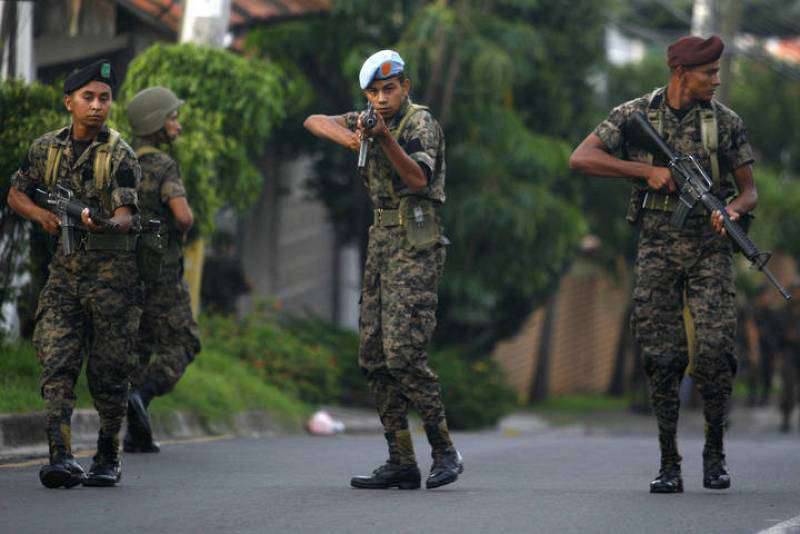
Currently, the number of Honduran armed forces is about 8,5 thousand people. In addition, 60 thousand people are in the reserve of the armed forces. The Armed Forces include ground forces, air force and naval forces. The ground forces have 5,5 thous. Military personnel and include 5 infantry brigades (101-i, 105-i, 110-i, 115-i, 120-i) and the command of the Special Operations Forces, as well as separate units of the army - 10- th infantry battalion, 1 th military engineering battalion and a separate command of logistics support of the ground forces. The 101 Infantry Brigade consists of the 11 Infantry Battalion, the 4 Infantry Battalion and the 1 Armored Cavalry Regiment. The 105 Infantry Brigade consists of the 3, 4 and 14 infantry battalions and the 2 artillery battalion. The 110 Infantry Brigade includes the 6 and 9 infantry battalions, the 1 battalion of battalions. The 115 Infantry Brigade consists of the 5, 15 and 16 infantry battalions and the Army Military Training Center. The 120 Infantry Brigade includes the 7 Infantry and 12 Infantry Battalions. Special operations forces include the 1 and 2 infantry battalions, the 1 artillery battalion and the 1 battalion for special purposes.
In the arsenal of the ground forces of the country are: 12 light tanks British-made Scorpion, 89 BRM ((16 Israeli RBY-1, 69 English Saladin, 1 Sultan, 3 Simiter), 48 artillery weapons and 120 mortars, 88 anti-aircraft guns. The Honduran Air Force has 1800 military personnel, the Air Force has 49 combat aircraft and 12 helicopters, but in reality a significant part of the aviation equipment is in storage, and those aircraft and helicopters that are in service are also represented by outdated samples. Among the military aircraft of the Honduran Air Force, 6 old American F-5 (4 E, 2 combat training F), 6 American anti-guerrilla light attack aircraft A-37B. In addition, there are 11 French Super Myster fighters, 2 old AC-47s and a number of other aircraft in storage. Aviation is represented by 1 aircraft C-130A, 2 Cessna-182, 1 Cessna-185, 5 Cessna-210, 1 IAI-201, 2 PA-31, 2 Czech L-410, 1 Brazilian ERJ135. in addition, a significant amount of old transport sa molet is in storage. Honduran pilots learn to fly on 7 Brazilian aircraft EMB-312, 7 American MXT-7-180. In addition, the country's air force has 10 helicopters - 6 American Bell-412, 1 Bell-429, 2 UH-1H, 1 French AS350.
Honduran naval forces number around 1 thousand officers and sailors and are armed with modern patrol and landing craft 12. Among them, the 2 boats of the Dutch type “Lempira” (“Damen 4207”), the 6 boats “Damen 1102” should be noted. In addition, the Navy has 30 small boats with weak armament. These are: 3 boats “Guaymuras”, 5 boats “Nakaome”, 3 boats “Tegucigalpa”, 1 boats “Hamelecan”, 8 river boats “Piran” and 10 river boats “Boston”. In addition to seafarers, the Honduran Navy also includes the Marine Corps 1 battalion. Sometimes units of the Honduran armed forces take part in operations conducted by the American army on the territory of other states. Thus, from 3 in August 2003 to 4 in May 2004, the Honduran contingent of 368 troops was stationed in Iraq as part of the Plus Ultra brigade. This brigade consisted of 2500 troops from Spain, the Dominican Republic, El Salvador, Honduras and Nicaragua, and was part of the Center-West division, under Polish command (more than half of the soldiers in the brigade were Spaniards, the rest were officers and soldiers from central America).
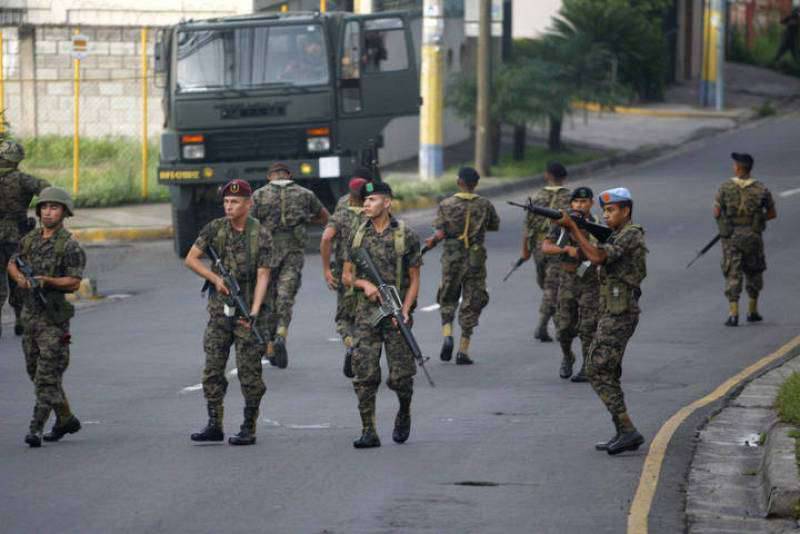
Recruitment of the armed forces of Honduras is carried out by conscription for a period of 2 year. The officers of the Honduran armed forces are trained in the following military schools: Honduras University of Defense in Tegucigalpa, Honduras Military Academy General Francisco Morazana in Las Tapías, Military Aviation Academy at the Air Base in Comayagua, Honduran Naval Academy in the port of La Ceiba on the shores of the Caribbean Sea, Northern Military High School in San Pedro Sula. In the armed forces of the country established military ranks, similar to the hierarchy of military ranks of other Central American countries, but having their own specifics. In the Army and Air Force are established, in general, identical, but with some differences, titles: 1) divisional general, 2) brigadier general, 3) colonel (colonel of aviation), 4) lieutenant colonel (lieutenant colonel of aviation), 5) major (major Aviation), 6) Captain (Aviation Captain), 7) Lt. (Aviation Lt.), 8) Sub Lt. (Aviation Lt.), 9) Sub-Officer 3 Class Commander (Sub-Officer 3 Class Aviation Chef), 10) Sub Officer Commander 2 Class (Sub-Officer 2 Class Senior Master of Aviation), 11) Sub-Officer Commander 1 Class (Sub-o 1 fizzer class aviation master), 12) sergeant major 13) first sergeant 14) second sergeant 15) third sergeant, 16) corporal (corporal of air safety), 17) soldiers (air safety soldier). Honduras naval forces have the following titles: 1) Vice-Admiral, 2) Rear-Admiral, 3) Ship's Captain, 4) Frigate Captain, 5) Corvette Captain, 6) Ship's Lieutenant, 7) Frigate Lieutenant, 8) Alfehr 9 class 1 countermaster, 10 class 2 countermaster, 11 class 3 countermaster, 12) sergeant major, 13) maritime first sergeant, 14) maritime second sergeant, 15) maritime third sergeant, 16) maritime seaman third sergeant, 17) maritime second sergeant, XNUMX) maritime third sergeant, XNUMX) maritime maritime third sergeant, XNUMX) maritime third sergeant, XNUMX) maritime third sergeant, XNUMX) maritime seaman sergeant, XNUMX) ) sailor.
The command of the country's armed forces is carried out by the president through the state secretary of national defense and the chief of the general staff. Currently, the post of Chief of General Staff is occupied by Brigadier General Francisco Isaias Alvarez Urbino. The commander of the ground forces is Brigadier General René Orlando Fonseca, the air force is Brigadier General Jorge Alberto Fernandez López, and the naval force is captain of the ship Jesus Benitez. At present, Honduras continues to be one of the key US satellites in Central America. The American leadership regards Honduras as one of the most obedient allies in Latin America. At the same time, Honduras is one of the most problematic countries of the “isthmus”. There is a very low standard of living, a high level of crime, which prompts the government to use the army, above all, to perform police functions.
Costa Rica: the most peaceful country and its Civil Guard
Costa Rica is the most unusual country in Central America. Firstly, there is a very high standard of living compared to other countries in the region (2 is in the region after Panama), and secondly, it is considered a “white” country. “White” descendants of European immigrants from Spain (Galicia and Aragon) make up 65,8% of the population of Costa Rica, 13,6% are metis, 6,7% are mulattos, 2,4% are Indians and 1% are Negroes. Another "highlight" of Costa Rica - the lack of an army. Adopted by 7 on November 1949, the Costa Rican Constitution prohibited the creation and maintenance of a permanent professional army in peacetime. Before 1949, Costa Rica had its own armed forces. By the way, unlike other countries in Central and South America, Costa Rica avoided the war of independence. In 1821, after the proclamation of independence of the captaincy general of Guatemala, Costa Rica also became an independent country, and its residents learned about the country's sovereignty two months late. Then, in 1821, the construction of a national army began. However, relatively calm by Central American standards, Costa Rica didn’t bother with military issues. By 1890, the armed forces of the country consisted of a regular army of 600 soldiers and officers, and a reserve police, which included more than 31 thousand reservists. In 1921, Costa Rica attempted to make territorial claims against neighboring Panama and introduced parts of its troops into Panamanian territory, but soon the United States intervened in the conflict, after which Costa Rican troops left Panama. In accordance with the “Treaty of Peace and Friendship” with the United States and the “Convention on Arms Reduction” signed in 1923 in Washington, Costa Rica pledged to have an army of no more than 2 thousand troops.
By December 1948, the total strength of the armed forces of Costa Rica was 1200 people. However, in 1948-1949. there was a civil war in the country, after which it was decided to liquidate the armed forces. Instead, the armed forces created the Costa Rican Civil Guard. In 1952, the number of civil guards was 500 people, 2 thousand more people served in the Costa Rican National Police. The training of officers of the Civil Guard was carried out in the "School of the Americas" in the Panama Canal zone, police officers were trained in the United States. Despite the fact that, formally, the Civil Guard did not have the status of armed forces, armored personnel carriers were at the disposal of the guard units, and in 1964, an aviation squadron was created as part of the Civil Guard. By 1976, the number of civil guards, including the coast guard and aviation, was about 5 thousand people. The most significant military-technical, financial and organizational assistance in strengthening the Costa Rican Civil Guard continued to be provided by the United States. So, the United States supplied weapons, trained officers of the Civil Guard.
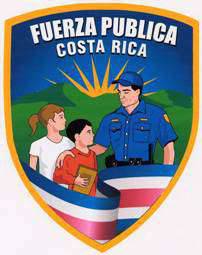 The United States began to actively assist Costa Rica in strengthening the Civil Guard since the early 1980s, after the victory of the Sandinistas in Nicaragua. Although there was no guerrilla movement in Costa Rica, the United States, nevertheless, did not want to spread revolutionary ideas to this country, for which great attention was paid to strengthening police services. In 1982, with the help of the USA, the special service DIS was created - the Security and Intelligence Directorate, two civilian anti-terrorist companies were formed - the first company was stationed in the San Juan River area and consisted of 260 servicemen, and the second stationed on the Atlantic coast and 100 troops. Also in 1982, an OPEN volunteer society was created, in 7-14-week courses where everyone was taught how to handle small arms, the basics of battle tactics and medical care. Thus was prepared the 5-thousandth reserve of the Civil Guard. In 1985, under the guidance of instructors from the American Green Berets, a border guard battalion of “Relampagos” with 800 people was established. and a special purpose battalion of 750 men. The need to create special forces was due to the growth of conflicts with militants of the Nicaraguan Contras, several of whose camps operated in Costa Rica. By 1993, the total number of armed forces of Costa Rica (civil guard, maritime security and border police) was 12 thousand people. In 1996, the country's power structures were reformed, according to which the civil guard, maritime security and border police were merged into the "Social Forces of Costa Rica". The stabilization of the political situation in Central America contributed to the reduction in the number of armed forces in Costa Rica from 12 thousand people in 1993 to 7 thousand people in 1998.
The United States began to actively assist Costa Rica in strengthening the Civil Guard since the early 1980s, after the victory of the Sandinistas in Nicaragua. Although there was no guerrilla movement in Costa Rica, the United States, nevertheless, did not want to spread revolutionary ideas to this country, for which great attention was paid to strengthening police services. In 1982, with the help of the USA, the special service DIS was created - the Security and Intelligence Directorate, two civilian anti-terrorist companies were formed - the first company was stationed in the San Juan River area and consisted of 260 servicemen, and the second stationed on the Atlantic coast and 100 troops. Also in 1982, an OPEN volunteer society was created, in 7-14-week courses where everyone was taught how to handle small arms, the basics of battle tactics and medical care. Thus was prepared the 5-thousandth reserve of the Civil Guard. In 1985, under the guidance of instructors from the American Green Berets, a border guard battalion of “Relampagos” with 800 people was established. and a special purpose battalion of 750 men. The need to create special forces was due to the growth of conflicts with militants of the Nicaraguan Contras, several of whose camps operated in Costa Rica. By 1993, the total number of armed forces of Costa Rica (civil guard, maritime security and border police) was 12 thousand people. In 1996, the country's power structures were reformed, according to which the civil guard, maritime security and border police were merged into the "Social Forces of Costa Rica". The stabilization of the political situation in Central America contributed to the reduction in the number of armed forces in Costa Rica from 12 thousand people in 1993 to 7 thousand people in 1998. Currently, the security forces of Costa Rica are headed by the head of state through the Ministry of Public Security. The Ministry of Public Security is subordinate to: Costa Rican Civil Guard (4,5 thousand), which includes the Aerial Surveillance Service; National Police (2 thousand people), Border Police (2,5 thousand people), Coast Guard (400 people). As part of the Costa Rican Civil Guard, the Air Surveillance Service is armed with 1 light aircraft DHC-7, 2 aircraft Cessna 210, 2 aircraft PA-31 "Navajo" and 1 aircraft PA-34-200T., As well as 1 helicopter MD 600, and also X-NUMX helicopter MD 7. . Civilian Land Forces include the 3 territorial companies in Alajül, Cartago, Guanacaste, Heredia, Limon, Puntarenas and San José, and the 1 battalion - the 1 presidential guard battalion (1 battalion of border security (on the border with Nicaragua) and the 60 marntheNNMX march and the 92NMX march and the 80 11 battalion of the Presidential Guard . In addition, there is an anti-terrorism Special Action Group of 3-4 fighters divided into assault groups for XNUMX people and teams for XNUMX-XNUMX people. All of these forces are designed to ensure the national security of Costa Rica, to combat crime, drug trafficking and illegal migration, and, if necessary, to protect the borders of the state.
Panama: when the police replaced the army
Costa Rica’s southeastern neighbor, Panama, has also not had its own armed forces since 1990. The elimination of the country's armed forces was the result of the American military operation 1989-1990, as a result of which the President of Panama, General Manuel Noriega, was overthrown, arrested and taken to the United States. Before 1989, the country possessed sufficiently large by Central American standards armed forces, whose history was inextricably linked with the history of Panama itself. The first paramilitary units in Panama appeared in 1821, when Central America fought against the Spanish colonialists. Then, the lands of modern Panama became part of Greater Colombia, and after its collapse in 1830, they became part of the Republic of New Granada, which existed before 1858 and included the territory of Panama, Colombia, as well as part of the lands that now belong to Ecuador and Venezuela.
Around the 1840-x. great interest in the Isthmus of Panama began to show the United States of America. It was under American influence that Panama was separated from Colombia. 2 November 1903 The ships of the US Navy arrived in Panama, and 3 November 1903 the independence of Panama was declared. Already 18 November 1903 of the year between Panama and the United States signed an agreement according to which the United States received the right to deploy its armed forces on Panamanian territory and to control the Panama Canal zone. Since that time, Panama has become a complete US satellite, actually under external control. In 1946, the Latin American Training Center was established in the Panama Canal zone, on the territory of the American military base Fort Amador, later moved to Fort Gulik base and renamed the School of the Americas. Here, under the guidance of instructors of the US Army, military personnel from many countries of Central and South America received training. The defense and security of Panama at this time was provided by units of the national police, on the basis of which the Panama National Guard was established in December 1953. In 1953, the National Guard consisted of 2000 soldiers armed with small arms, mostly American-made. The National Guard of Panama regularly participated in the suppression of student and peasant uprisings in the country, including in battles with small partisan groups intensified in the 1950-1960-s.
October 11 A military coup in Panama, organized by a group of National Guard officers who sympathized with left-nationalist and anti-imperialist ideas, took place in Panama. Lieutenant Colonel Omar Efrain Torrijos Herrera (1968-1929) came to power in the country - a professional military man who from 1981 held the post of executive secretary of the National Guard of Panama, and before that commanded the 1966 military zone covering the north-western province of Chiriquí. A graduate of the military school. Gerardo Barrios in El Salvador, Omar Torrijos practically from the first days of his service began to create in the ranks of the National Guard an illegal revolutionary officer organization. With the arrival of Torrijos, relations between Panama and the United States have cracked. So, Torrijos refused to extend the US lease agreement for a military base in Rio Hato. In addition, in 5, the Panama Canal Agreement and the Permanent Neutrality Agreement and the operation of the canal were signed, providing for the return of the canal to the jurisdiction of Panama. The social reforms and achievements of Panama under Omar Torrijos require a separate article. After the death of Torrijos in a plane crash, clearly set up by his enemies, actual power in the country fell into the hands of General Manuel Noriega (born 1977), head of the Military Intelligence and Counterintelligence Directorate of the General Staff of the National Guard, who became commander of the National Guard and, formally not holding the post states, however, exercised real leadership of the country. In 1934, the National Guard was transformed into the National Defense Forces of Panama. By this time, Panama did not use military aid from the United States. Understanding perfectly well that complications in relations with the United States are fraught with intervention, Noriega increased the strength of the National Defense Forces to 1983 thousand people, and also created Digidad volunteer battalions with a total of 12 thousand people armed with small arms from the warehouses of the National Guard. The Panama National Defense Forces included 5's ground forces, air force, and naval forces. The ground forces numbered 1989 thous. Servicemen and included 11,5 infantry companies, 7 parachute company and militia battalions, armed with 1 armored vehicles. The air force, numbering 28 military personnel, had 200 aircraft and 23 helicopters. The naval forces numbered 20 people were armed with 300 patrol boats. But in December 8, as a result of the American invasion of Panama, the regime of General Noriega was overthrown.
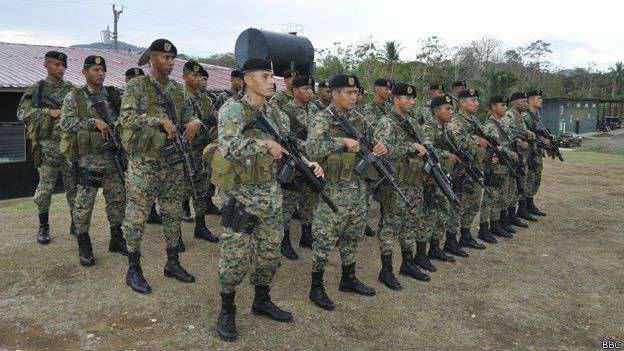
10 February 1990, the new pro-American president of Panama, Guillermo Endara, announced the disbandment of the armed forces. Currently, the Ministry of Public Security is responsible for ensuring the national security of Panama. He is responsible for the Civilian Security Forces: 1) Panama National Police, 2) Panama National Air and Maritime Service, 3) Panama National Border Guard. The National Police of Panama has 11 thousand officers and includes the 1 presidential guard battalion, the 1 military police battalion, the 8 individual military police companies, the 18 police company and the special forces unit. The air service has a 400 man and is armed with 15 light and transport aircraft and a 22 helicopter. The naval service numbers 600 people and is armed with 5 large and 13 small patrol boats, 9 auxiliary ships and boats. The National Border Service of Panama has over 4 thousand troops. It is precisely this militarized structure that is entrusted with the main tasks of defending the borders of Panama, but also the border guards are involved in ensuring national security, constitutional order and in the fight against crime. Currently, the Panamanian National Border Guard includes 7 combat battalions and 1 logistics battalion. On the border with Colombia are deployed in the Eastern Brigade 6 battalion - the Caribbean battalion, Central Battalion, Pacific Battalion, River Battalion, battalion of them. General José de Fabregas and the battalion of logistics. A western special purpose battalion is stationed on the border with the Republic of Costa Rica, which also includes special forces companies 3 - anti-drug, jungle operations, attacks and the introduction of the Cobra.
Thus, at present, Panama has a lot in common with Costa Rica in ensuring the country's defense - it also abandoned regular armed forces and is content with paramilitary police forces, which, however, are comparable in number to those of other Central American states.
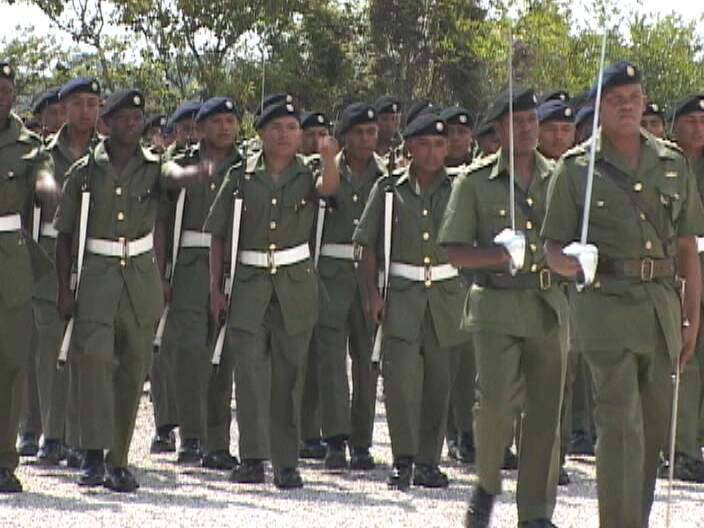
The defense forces of the smallest country "Peremyshka"
Concluding the review of the armed forces of Central America, let us tell you about what the army of Belize is - the seventh country of the “Isthmus”, which is not often mentioned in the media. Belize is the only English-speaking country on the Isthmus. This is a former British colony, before 1973, called “British Honduras”. Belize gained political independence in 1981. The population of the country is more than 322 thousand people, while 49,7% of the population falls in the Spanish-Indian metis (English-speaking), 22,2% - on the Anglo-African mulattoes, 9,9% - on the Mayan Indians, 4,6% - on the “Garifuna "(Afro-Indian mestizos), another 4,6% - on" whites "(mostly German Mennonites) and 3,3% - on immigrants from China, India and Arab countries. The history of the armed forces of Belize began in the colonial era and dates back to 1817, when the Honduran royal militia was created. Later this structure underwent many renames and by the 1970 years. was called the British Honduras Voluntary Guard (since 1973 was the Belize Volunteer Guard). In 1978, the Belize Defense Forces were established on the basis of the Belize Volunteer Guard. The main assistance in organizing, providing military equipment and weapons, financing the Belize Defense Forces is traditionally provided by the United Kingdom. Prior to 2011, British units were located in Belize, one of whose tasks was, among other things, to ensure the country's security from territorial claims from neighboring Guatemala.
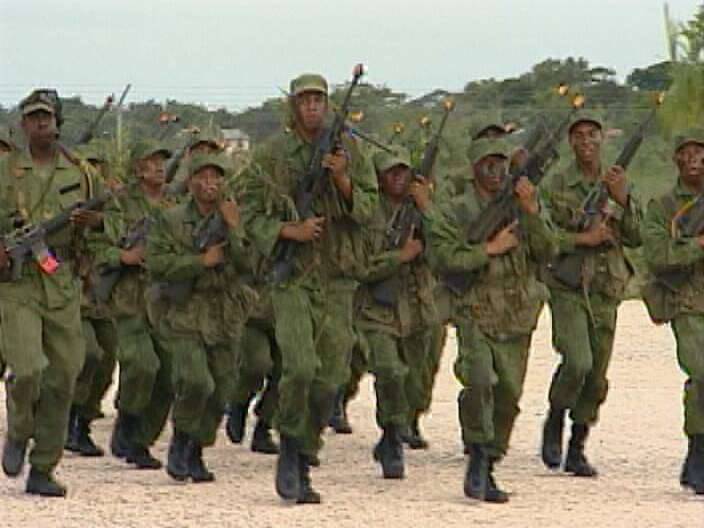
The Belize Defense Forces, the Police Department and the National Coast Guard are currently subordinate to the Ministry of National Security of Belize. The strength of the Belize Defense Force is 1050 military personnel. Recruitment is carried out on a contractual basis, and the number of those who want to enter military service is three times the number of available vacancies. The Belize Defense Forces include: 3 infantry battalion, each of which consists, in turn, of three infantry companies; 3 reserve companies; 1 support team; 1 aviation wing. In addition, there is a Belize Police Department in the country, which serves 1200 police officers and 700 civil servants. Assistance in the training of personnel and maintenance of military equipment to the Belize Defense Forces is provided by British military advisers located in the country. Of course, the military potential of Belize is insignificant and in the event of an attack on this country even by the same Guatemala, the country's Defense Forces have no chance of winning. But, since Belize is a former British colony and is protected by the UK, in the event of conflict, the country's Defense Forces can always count on the operational assistance of the British army, air force and navy.
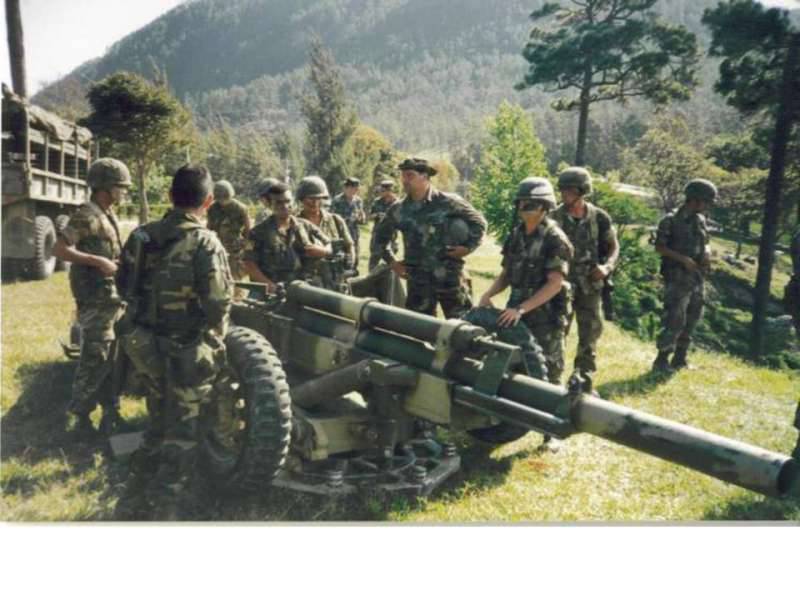
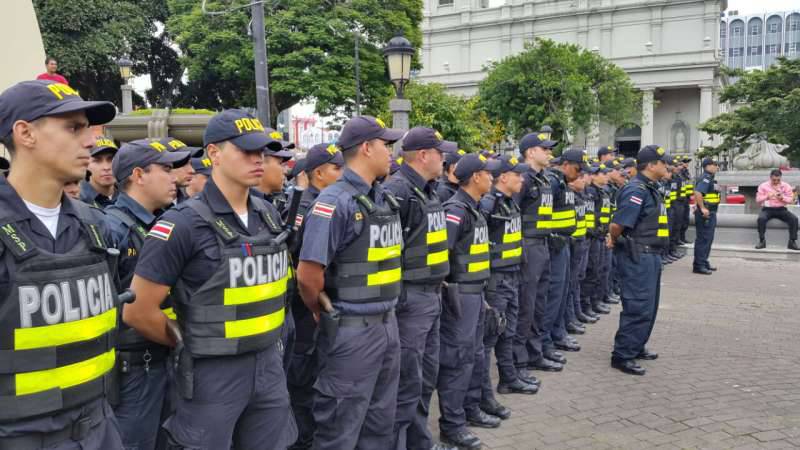
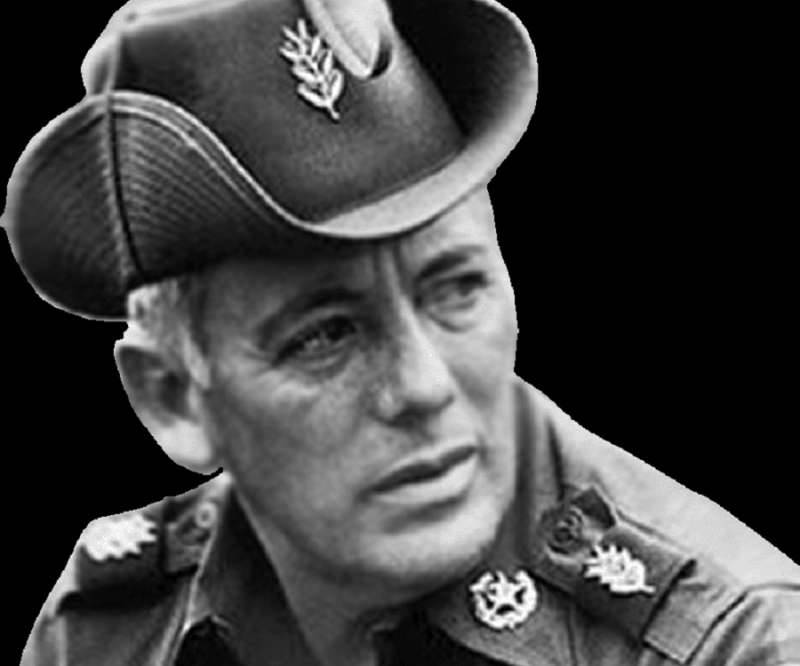
Information